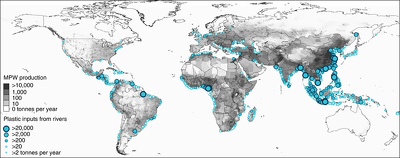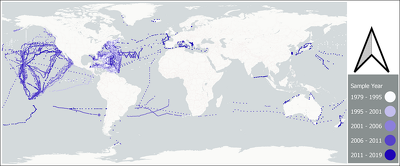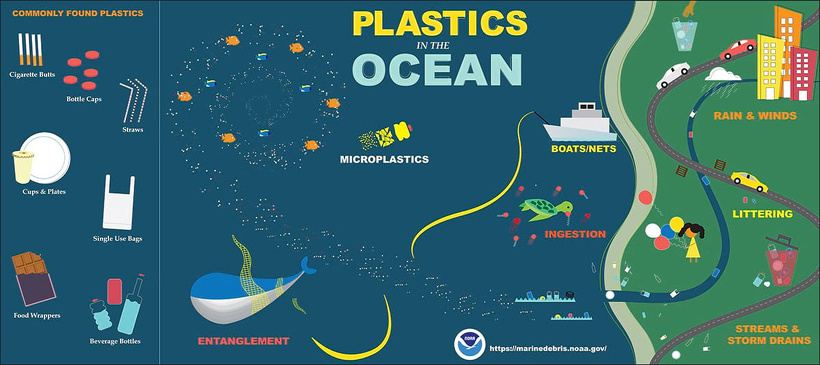Home | Category: Ocean Environmental Issues
PLASTIC IN THE OCEAN
Plastic is one of the worst forms of pollution in the ocean. It is particularly dangerous and troublesome because it takes so long to break down. Plastic bags and flotsam endanger a number of marine creatures. Sea birds have been found with bottle caps and plastic in their stomach. Seals have gotten trapped is six-pack holders. Turtles have choked on plastic bags they mistook for jellyfish. Plastic also provides a means for destructive sea worms, barnacles and mollusk to hitch hike across the oceans. According to the United Nations an estimated 1 million seabirds choke or become entangled in plastic nets or other debris every year. An estimated 100,000 seals, sea lions, whales, dolphins, other marines mammals and sea turtles die from floating plastic annually.
According to the New York Times: Everything from fish to whales can become entangled, and animals often mistake it for food and end up starving to death with stomachs full of plastic.
Ocean plastics that do not end up asphyxiating an albatross or entangling an elephant seal eventually break down into microplastics, which penetrate every branch of the food web and are nearly impossible to remove from the environment. [Source: Annie Roth, New York Times, May 7, 2022]
The world’s oceans contain five gyres, large systems of circular currents powered by global wind patterns and forces created by Earth’s rotation. They act like enormous whirlpools, so anything floating within one will eventually be pulled into its center. For nearly a century, floating plastic waste has been pouring into the gyres, creating an assortment of garbage patches. The largest, the Great Pacific Patch, is halfway between Hawaii and California and contains at least 79,000 tons of plastic, according to the Ocean Cleanup Foundation. All that trash turns out to be a great foothold for living things.
Large-scale consumption and disposal of plastics since the 1950s has led to large scale accumulation of the nonbiodegradable material in the world’s oceans. The plastic products reach remote areas, including the open ocean via storm runoff and littering. Plastic pollution on the surface of the ocean is made up mainly of particles smaller than 1 centimeters (0.39 inch) in diameter and microplastics (See Below), originating from bigger pieces of plastic that have broken down or commonly used cosmetics that contain microbeads. “These microplastics have an influence on the behavior and the food chain of marine organisms,” Andres Cozar, a researcher from the University of Cadiz in Spain, told Al Jazeera. “The tiny plastic fragments often accumulate contaminants that, if swallowed, can be passed to organisms during digestion — without forgetting the gastrointestinal obstructions, which are another of the most common problems with this type of waste.” [Source: Renee Lewis, Al Jazeera, July 1, 2014]
One study found that 40 percent of albatross chicks on Midway Atoll die from starvation and dehydration related to eating plastic garbage. Examinations of their stomach reveal colored bottle caps, gold tees, combs, fishing lines, spray nozzles, toothbrushes, cigarettes lighters, toy soldiers, brushes, Lego bricks, clothes pins, fishing lures and syringes that their parents mistook for food and regurgitated in the chick’s mouths. This has occurred even though Midway is situated in the middle of the Pacific, far from any industrial zones or population center, and has only a few people living on it
Related Articles: HUMANS AND THE OCEANS: MYTHS, PRODUCTS, ETIQUETTE AND DRUGS ioa.factsanddetails.com ; SHIPPING AND THE WORLD'S BIGGEST SHIPS ioa.factsanddetails.com ; POLLUTION IN THE SEA ioa.factsanddetails.com ; RED TIDES (HARMFUL ALGAL BLOOMS): DEAD ZONES, EUTROPHICATION, CAUSES AND IMPACTS ioa.factsanddetails.com ; TRASH AND DEBRIS IN THE OCEAN AND EFFORTS TO CLEAN IT UP ioa.factsanddetails.com
Websites and Resources: Animal Diversity Web (ADW) animaldiversity.org; National Oceanic and Atmospheric Administration (NOAA) noaa.gov; “Introduction to Physical Oceanography” by Robert Stewart , Texas A&M University, 2008 uv.es/hegigui/Kasper ; Fishbase fishbase.se ; Encyclopedia of Life eol.org ; Smithsonian Oceans Portal ocean.si.edu/ocean-life-ecosystems ; Woods Hole Oceanographic Institute whoi.edu ; Cousteau Society cousteau.org ; Monterey Bay Aquarium montereybayaquarium.org ; MarineBio marinebio.org/oceans/creatures
Microplastics
Microplastics are small plastic pieces less than five millimeters long which can be harmful to the ocean and aquatic life. Plastic debris can come in all shapes and sizes, but those that are less than five millimeters in length (or about the size of a sesame seed) are called “microplastics.” They includes microbeads, tiny pieces of polyethylene plastic added to health and beauty products, such as some cleansers and toothpastes. [Source: NOAA]
Microplastics come from a variety of sources, including from larger plastic debris that degrades into smaller and smaller pieces. In addition, microbeads, a type of microplastic, are very tiny pieces of manufactured polyethylene plastic that are added as exfoliants to health and beauty products, such as some cleansers and toothpastes. These tiny particles easily pass through water filtration systems and end up in the ocean, posing a potential threat to aquatic life.
As an emerging field of study, not a lot is known about microplastics and their impacts yet. The NOAA Marine Debris Program is leading efforts within NOAA to research this topic. Standardized field methods for collecting sediment, sand, and surface-water microplastic samples have been developed and continue to undergo testing. Eventually, field and laboratory protocols will allow for global comparisons of the amount of microplastics released into the environment, which is the first step in determining the final distribution, impacts, and fate of this debris.
Microbeads are not a recent problem. According to the United Nations Environment Programme, plastic microbeads first appeared in personal care products about fifty years ago, with plastics increasingly replacing natural ingredients. As recently as 2012, this issue was still relatively unknown, with an abundance of products containing plastic microbeads on the market and not a lot of awareness on the part of consumers. In December 2015, the U.S. enacted the Microbead-Free Waters Act of 2015, banning plastic microbeads in cosmetics and personal care products.
Millions of Tons of Plastic Trash in the World's Oceans
About 8 million to 10 million tons of plastic is dumped into the world’s oceans every year. Will Dunham of Reuters writes: The world’s oceans are clogged with plastic debris, but how much of it finds its way into the seas annually? Enough to place the equivalent of five grocery bags full of plastic trash on every foot (30 centimeters) of every nation’s coastline around the globe. That’s according to scientists who published their research in the journal Science, estimating that a staggering 8 million metric tones of plastic pollution enter the oceans each year from the world’s 192 coastal countries based on 2010 data. Based on rising waste levels, they estimated that more than 9 million tons would end up in the oceans in 2015. [Source: Will Dunham, Reuters, February 13, 2015]
China was responsible for the most ocean plastic pollution per year with an estimated 2.4 million tons, about 30 percent of the global total, followed by Indonesia, the Philippines, Vietnam, Sri Lanka, Thailand, Egypt, Malaysia, Nigeria and Bangladesh. The United States was the only rich industrialized nation in the top 20, and it ranked No. 20. Coastal EU nations combined would rank 18th.
The trash encompasses just about anything imaginable made of plastic including shopping bags, bottles, toys, food wrappers, fishing gear, cigarette filters, sunglasses, buckets and toilet seats. “In short, you name it and it is probably somewhere in the marine environment,” said Kara Lavender Law, a research professor of oceanography with the Massachusetts-based Sea Education Association.
The estimates were based on information including World Bank data for trash generated per person in all nations with a coastline, coastal population density, the amount of plastic waste countries produce and the quality of their waste-management practices. “I think this is a wake-up call for how much waste we produce,” said University of Georgia environmental engineering professor Jenna Jambeck.
The researchers calculated that 275 million tons of plastic waste was generated in the 192 coastal countries that year, with an estimated 8 million tons entering the ocean and a possible range between 4.8 million and 12.7 million tons. “The most pressing need is to capture plastic waste to prevent it from entering the environment,” Law said. “This means investing in waste management infrastructure, especially in those countries with rapidly developing economies.” In high-income countries, we also have a responsibility to reduce the amount of waste, especially plastic waste, that we produce,” she added.
88 Percent of Ocean’s Surface Contaminated by Plastic
In a report released in the summer of 2014, researchers studying plastic in the world’s oceans found plastic debris in 88 percent of samples taken from the ocean's surfaces at hundreds of sites around the globe. “Ocean currents carry plastic objects, which split into smaller and smaller fragments due to solar radiation,”Andres Cozar, a researcher from the University of Cadiz in Spain, said. “Those little pieces of plastics, known as microplastics, can last hundreds of years and were detected in 88 percent of the ocean surface sampled.” [Source: Renee Lewis, Al Jazeera, July 1, 2014]
Al Jazeera reported: Researchers at the University of Cadiz conducted the study, and the results were published in the journal Proceedings of the National Academy of Sciences. Ocean samples were taken as part of the Malaspina Circumnavigation Expedition from 2010 to 2011, aimed at studying the impact of global change — including population, globalization, climate and other factors — on the marine ecosystem.
Researchers had been aware of the massive plastic accumulation in the northern Pacific Ocean, called the Great Pacific Garbage Patch, estimated to be larger than Texas. But this study showed that plastics have accumulated in all five ocean gyres, or areas where currents converge. “Our results show that the high concentration of plastic is not a unique feature of the North Pacific but occurs in each of the subtropical gyres,” Carlos Duarte, coordinator of the Malaspina expedition, said in a release.
Much Plastic in the Open Ocean Comes from Ships Not Consumers, Report Says
A study published in September 2019 reported that most of the plastic bottles washing up on the shores of Inaccessible Island, a remote island the middle of the South Atlantic between Argentina and South Africa , probably come from Chinese merchant ships. According to AFP, The study offers evidence that the vast garbage patches floating in the middle of oceans, are less the product of people dumping single-use plastics in waterways or on land, than they are the result of merchant marine vessels tossing their waste overboard by the ton. The authors of the study published in the Proceedings of the National Academy of Sciences, or PNAS, collected thousands of pieces of waste during visits to the tiny island in 1984, 2009 and again in 2018.
“The island is located roughly midway in the South Atlantic gyre, a vast whirlpool of currents that has created what has come to be known as an oceanic garbage patch. While initial inspections of the trash washing up on the island showed labels indicating it had come from South America, some 2,000 miles (3,000 kilometers) to the west, by 2018 three-quarters of the garbage appeared to originate from Asia, mostly China. Many of the plastic bottles had been crushed with their tops screwed on tight, as is customary on board ships to save space, said report author Peter Ryan, director of the FitzPatrick Institute of African Ornithology at the University of Cape Town in South Africa.
“Around 90 percent of the bottles found had been produced in the previous two years, ruling out the possibility that they had been carried by ocean currents over the vast distance from Asia, which would normally take three to five years. Since the number of Asian fishing vessels has remained stable since the 1990s, while the number of Asian — and in particular, Chinese — cargo vessels has vastly increased in the Atlantic, the researchers concluded that the bottles must come from merchant vessels, which toss them overboard rather than dumping them as trash at ports."It's inescapable that it's from ships, and it's not coming from land," Ryan told AFP, . "A certain sector of the merchant fleet seems to be doing that, and it seems to be largely an Asian one," he said.
“Oceanographer Laurent Lebreton of the organization The Ocean Cleanup said that the oft-quoted figure of 80 percent of plastic pollution coming from the land does not apply to the high seas. He recalled having found huge clusters of nets created by fishing vessels in the North Pacific, known as "fish aggregating devices" to attract fish. "Often they don't retrieve them and they are lost. We have found several tons of them," said Lebreton,. "Everyone talks about saving the oceans by stopping using plastic bags, straws and single use packaging. That's important, but when we head out on the ocean, that's not necessarily what we find." .
Plastic Rocks Found on Remote Island Alarm Scientists
Plastic rocks found on the remote Brazilian island of Trindade have alarmed scientists. Reuters reported: Its geology has fascinated scientists for years. But the latest discovery on this remote turtle refuge, has terrified them. Melted plastic has become intertwined with rocks on the island - located more than 1,100 kilometers (700 miles) away from the mainland. And scientists say it's proof of mankind's growing influence over earth's geological cycles. [Source: Reuters, March 16, 2023]
Trindade Island is one of the world's most important conservation spots for green turtles - with thousands arriving each year to lay their eggs. The island’s only human inhabitants are members of the Brazilian navy — which maintains a base on the island and protects the nesting turtles. But its remoteness did not stop human activity from interfering.
Fernanda Avelar Santos, Geologist said:“The place where we found these samples (of plastic) is a permanently preserved area in Brazil, near the place green turtles lay their eggs. It has a unique biodiversity with endemic species of fish, coral reefs, marine birds and protected species of crab, for example."
Researchers at the Federal University of Parana couldn’t classify the rocks... So they ran chemical tests, which found that the plastics in the rocks are called “plastiglomerates” – made from a mixture of sedimentary granules and other debris held together by plastic. “We identified (the pollution) mainly comes from fishing nets, which is very common debris on Trinidade Island’s beaches. They (nets) are dragged by the marine currents and accumulate on the beach. When the temperature rises, this plastic melts and becomes embedded with the beach's natural material."
Combating Plastic Pollution in the Ocean
To draw attention to huge amount of plastic floating around in the world’s ocean. David de Rothschild, a young bearded activist from the famous banking family, constructed an 18-meter-long boat from 12,500 plastic bottles and sailed it across the Pacific. Marine biologist Marcus Eriksen and oceanographer Joel Paschal had a similar aim in mind with vessel made from 15,000 plastic bottles held together with recycled nets. In 2019, French swimmer Benoit Lecomte swam more than 300 nautical miles through the Great Pacific Garbage Patch to raise awareness about marine plastic pollution.
In February 2022, world leaders and representatives from nearly 200 countries at the United Nations environment assembly in Nairobi, Kenya, agreed to develop a treaty designed to bring an end to plastic pollution. According to CNBC: The resolution, which addresses the full lifecycle of plastic, including production, design and disposal, will be developed in 2022, 2023 and 2024 and is hoped an agreement to address the growing problem of plastic waste in the world’s oceans, rivers and landscapes can be reached by the end of 2024. [Source: Sam Meredith, CNBC, March 3 2022]
The U.N. Environment Programme has warned plastic pollution ballooned to 348 million metric tons in 2017, up from 2 million metric tons in 1950. It says plastic pollution has become a global industry valued at more than $522 billion and is expected to double in capacity by 2040. Inger Andersen, executive director of the U.N.agency, described the breakthrough as “a triumph by planet earth over single-use plastics.” “This is the most significant environmental multilateral deal since the Paris accord. It is an insurance policy for this generation and future ones, so they may live with plastic and not be doomed by it,” Andersen said.
Image Sources: Wikimedia Commons; YouTube, NOAA
Text Sources: National Oceanic and Atmospheric Administration (NOAA) noaa.gov; “Introduction to Physical Oceanography” by Robert Stewart , Texas A&M University, 2008 uv.es/hegigui/Kasper ; Wikipedia, National Geographic, Live Science, BBC, Smithsonian, New York Times, Washington Post, Los Angeles Times, The New Yorker, Reuters, Associated Press, Lonely Planet Guides and various books and other publications.
Last Updated March 2023






